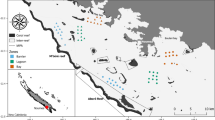Abstract
Long-term monitoring program of organisms is the most recommended for understanding changing processes on reefs. The video transect method presents advantages for that. Specialists state that it is important to make sure that the recorded coverage is always the same between campaigns, so that differences in results may be entirely attributed to environmental changes. This study aimed to test the capability of implementing this requirement through tracking simulation and its validity for monitoring the benthic communities of reefs using the video transect method. Ten transects 20 m long were established in Todos os Santos Bay coral reefs. Subsequent to the first transect capture, a second diver repeated the same track, simulating two different monitoring campaigns. Data were transformed and a matrix of similarity was generated using Bray–Curtis’ Index. ANOSIM analysis was performed to test the similarity of the ten transects and its repetitions. The result, R = 0.08 (P = 0.928), shows that reef monitoring using video transect, the way it is described in the literature, is appropriate, but it is important to consider some premises discussed in this work.
Similar content being viewed by others
References
Amaral, F. M. D., Silveira, S. R. M., Vasconcelos, S. L., & Ramos, C. A. C. (2006). Biodiversidade de cnidários bentônicos. In T. Vaske Júnior, R. P. Lessa, M. F. Nóbrega, F. M. D. Amaral, S. R. M. Silveira (Eds.), Arquipélago de São Pedro e São Paulo: Histórico e recursos naturais (pp. 42–55). Olinda: Livro Rápido.
Aronson, R. B., & Swanson, D. W. (1997). Video surveys of coral reefs: Uni- and multivariate applications. In: International coral reef symposium, 8, Panama. Proceedings Panama: International Society for Reef Studies (Vol. 2, pp. 1441–1446).
Aronson, R. B., Macintyre, I. G., Precht, W. F., Ivlusdoch, T. J. T., & Wapnick, C. M. (2002). The expanding scalc of species turnover events on coral reefs in Belize. Ecological Monographs, Washington, 72(2), 233–249.
Carleton, J. H., & Done, T. J. (1995). Quantitative video sampling of coral reef benthos: Large-scale application. Coral Reefs, Berlin, 14, 35–46. doi:10.1007/BF00304070.
Clarke, K. R., & Warwick, R. M. (1994). Change in marine communities: An approach to statistical analysis and interpretation (p. 144). Plymouth: Plymouth Marine Laboratory.
Cruz, I. C. S., Kikuchi, R. K. P., & Leão, Z. M. A. N. (2008). Use of the video transect method for characterizing the Itacolomis Reefs, Eastern Brazil. Brazilian Journal of Oceanography, São Paulo, 56(4), 271–280.
Dutra, L. X. C., Kikuchi, R. K. P., & Leão, Z. M. A. N. (2006). Todos os Santos Bay coral reef, Eastern Brazil, revisited after 40 years. In: International coral reef symposium, 10, Okinawa. Proceedings. Okinawa: International Society for Reef Studies (CD-ROM).
Dutra, L. X. C., Taboada, M. B., Vital, J. V. C., & Kikuchi, R. K. P. (2004). VITRA—video transect analyser. http://vitra.codigolivre.org.br. Accessed 9 July 2007.
GCRMN (2006). http://www.gcrmn.org/. Accessed 7 June 2007.
Graus, R. R., Macintyre, I. G., Herchenroder, B. E. (1984). Computer simulation of the reef zonation at Discovery Bay, Jamaica: Hurricane disruption and long-term physical oceanographic controls. Coral Reefs, Berlin, 3, 59–68. doi:10.1007/BF00263755.
Hill, J., & Wilkinson, C. (2004). Benthic communities. In: J. Hill & C. Wilkinson (Eds.), Methods for ecological monitoring of coral reefs: A resource for managers (pp. 38–40). Queensland: Australian Institute of Marine Science.
Hughes, T. P., Baird, A. H., Bellwood, D. R., Card, M., Connolly, S. R., Folke, C., et al. (2003). Climate change, human impacts, and the resilience of coral reefs. Science, 301, 929–933. doi:10.1126/science.1085046.
Hurlbert, S. H. (1984). Pseudoreplication and the design of ecological field experiments. Ecological Monographs, Washington, 54(2), 187–211. doi:10.2307/1942661.
Knowlton, N. (2008). Coral reefs. Current biology. London, 18(1), 18–21.
Meyer, D. L., Bries, J. M., Greenstein, B. J., & Debrot, A. O. (2003). Preservation of in situ reef framework in regions of low hurricane frequency: Pleistocene of Curaçao and Bonaire, Southern Caribbean. Lethaia, Oslo, 36(3), 273–286. doi:10.1080/00241160310004675.
Moberg, F., & Folke, C. (1999). Ecological goods and services of coral reef ecosystems. Ecological Economics, Amsterdam, 29, 215–233. doi:10.1016/S0921-8009(99)00009-9.
Page, C., Coleman, G., Ninio, R., & Osborne, K. (2001). Surveys of benthic reef communities using underwater video. Long-term monitoring of the great barrier reef—standard operational procedure number 7 (p. 49). Townsville: Australian Institute of Marine Science.
Peters, R. H. (1991). A critical for ecology (p. 366). Cambridge: Cambridge University Press.
Reaka-Kudla, M. L. (1997). The global biodiversity of coral reefs: A comparison with rain forests. In: M. L. Reaka-Kudla, D. O. Wilson, E. O. Wilson (Eds.), Biodiversity II. Understanding and protecting our biological resources (pp. 83–108). Washington: Joseph Henry.
Rogers, C. S., Garrison, G., & Grober, R., Hillis, Z.-M., Frankie, M. A. (2001). Coral reef monitoring manual for the Caribbean and Western Atlantic (p. 110). St. John: Virgin Islands National Park.
Segal, B., & Castro, C. B. (2001). Proposed method for coral cover assessment: A case study in Abrolhos, Brazil. Bulletin of Marine Science. Coral Gables, 69(2), 487–496.
Villaça, R., & Pitombo, F. B. (1997). Benthic communities of shallow-water reefs of Abrolhos, Brazil. Revista Brasileira de Oceanografia, São Paulo, 45(1/2), 35–43.
Author information
Authors and Affiliations
Corresponding author
Rights and permissions
About this article
Cite this article
Ramos, C.A.C., Amaral, F.D., de Kikuchi, R.K.P. et al. Quantification of reef benthos communities and variability inherent to the monitoring using video transect method. Environ Monit Assess 162, 95–101 (2010). https://doi.org/10.1007/s10661-009-0778-z
Received:
Accepted:
Published:
Issue Date:
DOI: https://doi.org/10.1007/s10661-009-0778-z




